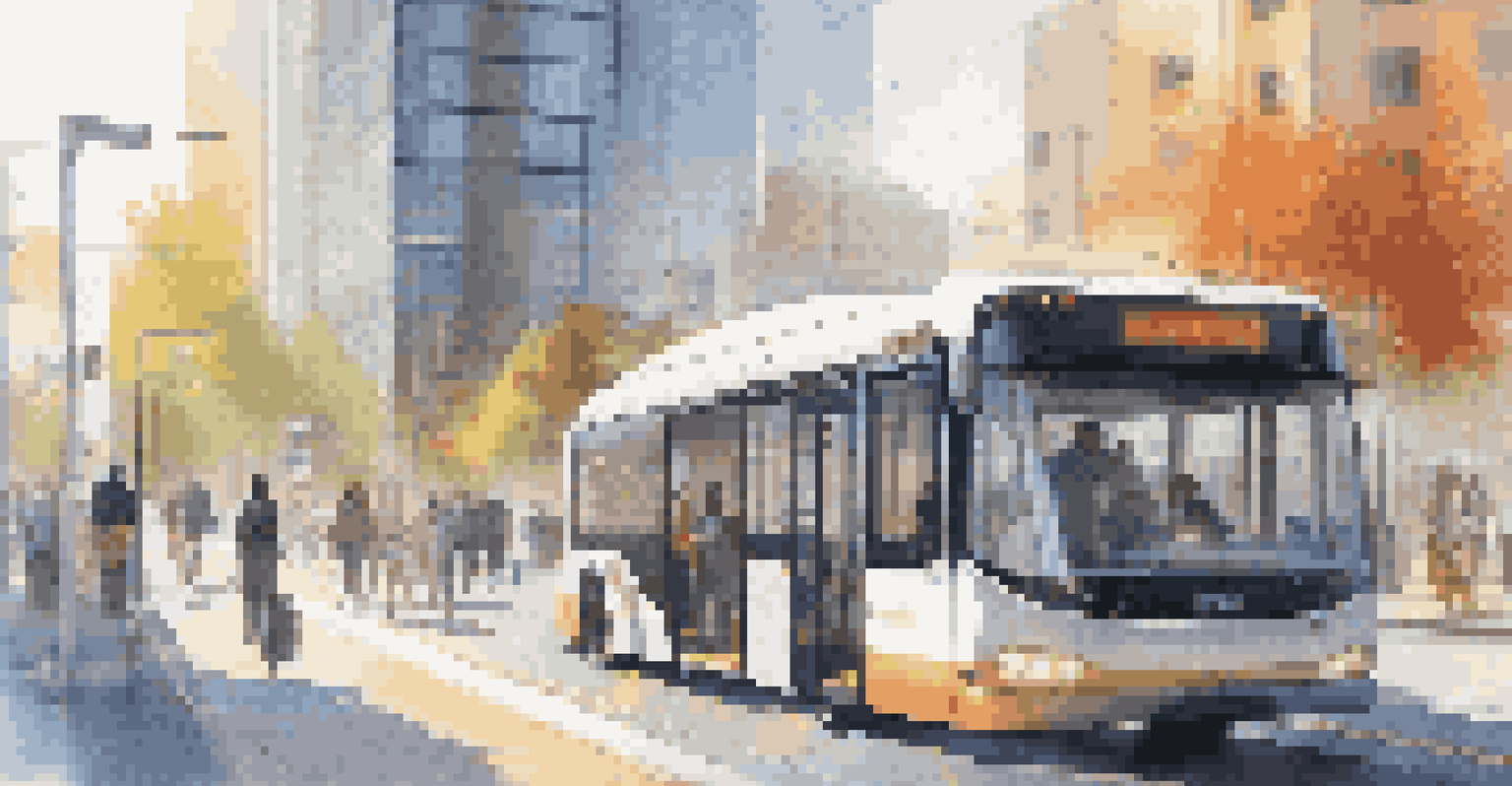Urban Mobility Trends: Enhancing Connectivity in Living Spaces

The Rise of Smart Cities and Their Impact on Urban Mobility
Smart cities are revolutionizing urban mobility by integrating technology with everyday life. These cities use data and connectivity to enhance transportation systems, making them more efficient and user-friendly. For example, real-time traffic updates help commuters choose the best routes, reducing congestion and travel time.
The future of mobility is not just about getting from point A to point B; it’s about connecting people, places, and ideas.
Moreover, smart cities often incorporate various modes of transport, such as bikes, buses, and rideshares into a unified system. This integration allows residents to switch seamlessly between options, promoting a more sustainable lifestyle. As a result, urban dwellers find it easier to navigate their environments, fostering a sense of community.
Ultimately, the emergence of smart cities signals a shift towards a more interconnected urban landscape. By prioritizing technology in mobility solutions, cities aim to enhance the quality of life for their residents, making urban areas more accessible and enjoyable.
The Role of Micro-Mobility in Urban Connectivity
Micro-mobility solutions, such as e-scooters and bike-sharing programs, are gaining popularity in urban settings. These options provide convenient transport for short distances, reducing reliance on cars and alleviating traffic congestion. Picture a busy city street where individuals zip by on e-scooters, effortlessly navigating their way to work or leisure activities.

Additionally, micro-mobility promotes last-mile connectivity, bridging the gap between public transportation and final destinations. This trend encourages more people to opt for public transport as they can easily access their homes or offices once they disembark. Consequently, cities can see a reduction in overall vehicle emissions, contributing positively to the environment.
Smart Cities Enhance Urban Mobility
By integrating technology and various transport modes, smart cities are making urban mobility more efficient and user-friendly.
As urban areas embrace micro-mobility, they also enhance the overall urban experience. By providing diverse transportation options, cities cater to various preferences and needs, ultimately fostering a more inclusive environment for all residents.
Public Transit Innovations Transforming Urban Mobility
Public transit systems are undergoing significant innovations to improve urban mobility. From autonomous buses to mobile ticketing apps, these advancements make it easier for commuters to navigate their routes. Imagine hopping on a self-driving bus that knows exactly when to pick you up and drop you off, all thanks to smart technology.
Sustainable urban mobility is not just a goal; it's a commitment to future generations.
Furthermore, cities are investing in expanding and upgrading their transit infrastructure, making it more accessible and reliable. Improved frequency and coverage of services encourage more people to utilize public transport rather than driving. The ripple effect is clear: less congestion, reduced emissions, and more vibrant urban spaces.
These innovations not only enhance the efficiency of public transit but also promote social equity. By making transportation more accessible to underserved communities, cities can ensure that everyone has the opportunity to thrive in an ever-evolving urban landscape.
Sustainable Urban Mobility: A Path Towards Eco-Friendly Cities
Sustainability has become a cornerstone of urban mobility trends, reflecting a growing awareness of environmental issues. Cities are increasingly seeking ways to reduce their carbon footprints through greener transportation alternatives. For instance, electric buses and trains are becoming staples in many urban transit systems, drastically cutting down emissions.
Moreover, promoting walking and cycling as primary modes of transport is gaining traction. Cities are introducing pedestrian-friendly infrastructure and dedicated bike lanes to encourage these eco-friendly options. Imagine strolling through a bustling city center, surrounded by lush greenery and cyclists enjoying the fresh air.
Micro-Mobility Boosts Connectivity
E-scooters and bike-sharing programs promote last-mile connectivity, encouraging the use of public transport and reducing vehicular emissions.
As urban mobility evolves, the focus on sustainability signals a commitment to future generations. By integrating eco-friendly practices into transportation planning, cities work towards creating cleaner, healthier environments that benefit both residents and the planet.
The Importance of User-Centric Design in Urban Mobility
User-centric design plays a vital role in enhancing urban mobility, ensuring that solutions cater to the needs of residents. Design thinking emphasizes empathy and understanding, allowing urban planners to create transportation systems that are intuitive and user-friendly. For example, clear signage and wayfinding tools can make public transit much more navigable for everyone.
Moreover, involving the community in the planning process fosters a sense of ownership and engagement. By gathering feedback and insights from residents, cities can tailor their mobility solutions to better serve the population. Picture a city where residents feel empowered to influence the transportation options they use daily.
Ultimately, prioritizing user-centric design creates a more enjoyable and efficient urban mobility experience. When residents feel that their needs are met, they are more likely to embrace public transport and alternative modes of travel, leading to a more connected and harmonious urban environment.
The Future of Urban Mobility: Trends to Watch
As we look ahead, several emerging trends are poised to shape the future of urban mobility. One significant trend is the rise of mobility-as-a-service (MaaS), which combines various transportation options into a single accessible platform. This concept allows users to plan, book, and pay for multiple modes of transport in one seamless experience.
Another trend to watch is the increasing integration of artificial intelligence and big data into transportation systems. These technologies can optimize routes, enhance safety, and predict demand, creating smarter and more efficient urban mobility solutions. Imagine a world where your transportation options are tailored to your preferences and real-time conditions.
Sustainability Drives Urban Transport
Cities are prioritizing eco-friendly transportation options, such as electric buses and pedestrian-friendly infrastructure, to reduce their carbon footprints.
Lastly, the importance of equity in urban mobility cannot be overstated. As cities strive to create inclusive transportation systems, addressing the needs of marginalized communities will be essential. By focusing on equitable access, urban mobility can become a powerful tool for fostering social cohesion and improving overall quality of life.
Challenges and Solutions in Urban Mobility Development
Despite the exciting advancements in urban mobility, challenges remain that need addressing. One significant hurdle is funding and investment; many cities struggle to secure the necessary resources for large-scale projects. Innovative financing solutions, such as public-private partnerships, can help bridge this gap and fuel development.
Additionally, public resistance to change often hampers progress. Communities may be hesitant to embrace new transportation options or technologies, fearing disruption to their daily lives. Engaging residents through education and outreach can alleviate these concerns, demonstrating the benefits of innovative mobility solutions.

Finally, adapting to the rapid pace of technological change can be daunting for urban planners. Keeping up with trends while ensuring safety and accessibility requires careful consideration. By fostering a culture of collaboration among stakeholders, cities can navigate these challenges and create cohesive and effective urban mobility systems.
Conclusion: Embracing Connectivity for Urban Living
In conclusion, enhancing connectivity through urban mobility trends is essential for creating vibrant, livable spaces. As cities continue to innovate and adapt to the needs of their residents, the emphasis on technology, sustainability, and user-centric design will pave the way for a more connected urban experience. The future of urban mobility holds great promise, offering solutions that prioritize both efficiency and community well-being.
By embracing these trends, cities can improve the quality of life for their residents, making transportation more accessible and enjoyable. From micro-mobility options to public transit innovations, the landscape of urban mobility is evolving, and it’s an exciting time to be part of this transformation.
Ultimately, the journey towards enhanced connectivity in urban living spaces is a collaborative effort. By working together, cities and residents can shape a future where mobility is not just about getting from point A to B but about creating inclusive, thriving communities.